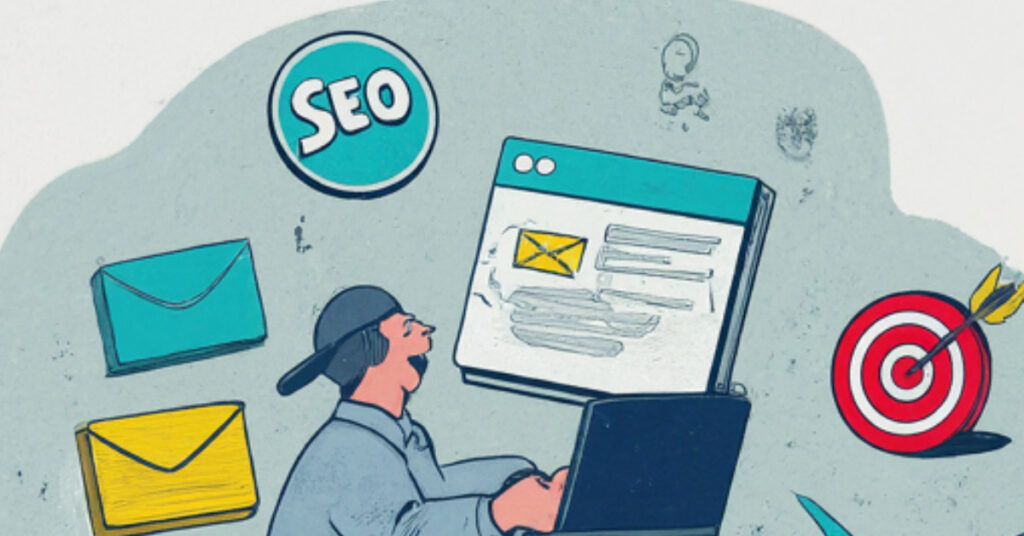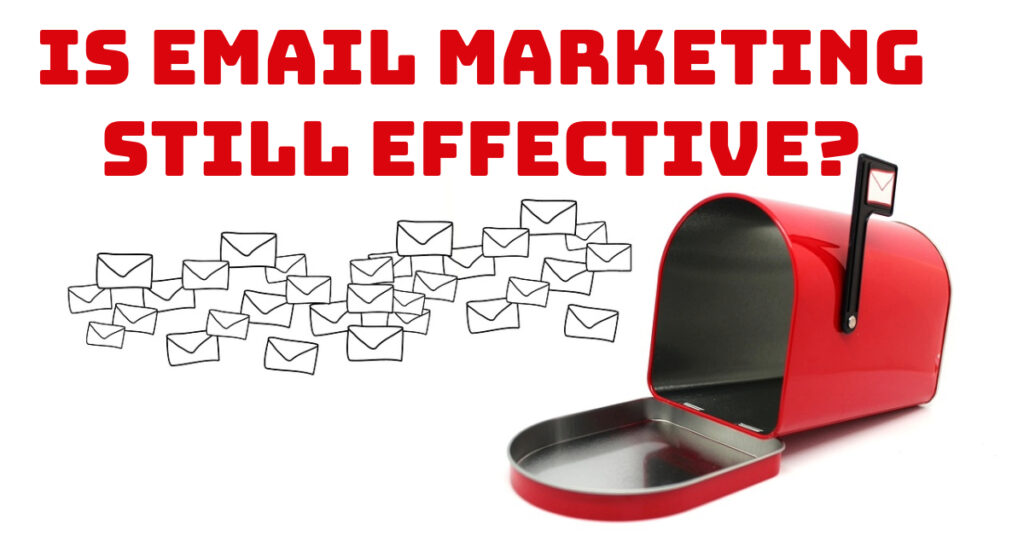As a Business Owner understanding how to use email and SEO together can help you improve your online presence and drive sales. By combining email marketing and SEO, your business can reach a wider audience, increase brand visibility, generate more leads, and ultimately boost sales.
Email marketing allows businesses to nurture leads, build relationships with customers, and drive repeat business.
SEO, on the other hand, helps you to improve your website’s visibility in search engine results, attracting organic traffic and increasing brand awareness.
By integrating these two strategies, you can create a powerful marketing funnel that effectively guides customers through the buying journey. Let’s dive deep into “Email Marketing and SEO”
Email Marketing in business
Email marketing is a powerful tool for small business owners to reach and engage with their target audience directly. By building an email list of potential and existing customers, you can send targeted messages about your products or services, special offers, and company news. This personalized communication helps nurture relationships, build brand loyalty, and drive sales.
SEO meaning in business
SEO, or Search Engine Optimization, is the practice of improving a website’s visibility and ranking on search engine results pages (SERPs) to attract organic (non-paid) traffic. In the context of business, it’s the process of improving a website’s position in search results to attract more potential customers and grow your market reach.
E marketing search engine optimization
Email marketing SEO or e marketing search engine optimization is the practice of combining email marketing strategies with SEO principles to achieve better results. It involves optimizing your email content for both subscribers and search engines, ultimately driving more traffic to your website and improving its visibility.
Email Marketing and SEO. Connection Between Them!

There is no direct conection between them but both support each other.
How Email Marketing boost SEO:
Link Building:
By including links to your website within your email content, you can encourage subscribers to click through and explore your site. This not only increases traffic but also helps build valuable backlinks, which are a key factor in search engine rankings.
Increased Website Traffic:
Email marketing allows you to directly drive traffic to your website by promoting specific pages or content. When subscribers click through these links, it signals to search engines that your content is relevant and valuable, potentially boosting your search rankings.
Improved Click-Through Rates (CTRs):
By crafting compelling email subject lines and relevant content, you can increase the likelihood of subscribers clicking through to your website. Higher CTRs demonstrate to search engines that your content is engaging and useful, which can positively impact your search rankings.
Social Media Sharing and Engagement:
Email marketing provides an opportunity to encourage subscribers to share your content on social media. When your content is shared and engaged with on social platforms, it can improve your website’s visibility and reach a wider audience, potentially leading to increased organic traffic.
Enhanced Brand Reputation:
Consistent and high-quality email campaigns help build trust and credibility with your audience. A strong brand reputation can positively influence search engine rankings, as search engines prioritize websites with a positive online presence.
How SEO improve Email Marketing:
Targeted email lists:
You can utilize keyword research to identify potential customers and segment your email list accordingly. This allows you to deliver highly relevant content and offers, increasing engagement and conversions.
Optimized subject lines:
Employing SEO best practices to craft compelling and keyword-rich subject lines improve email deliverability and open rates. By using relevant keywords which act as a main one topic for an email , you can increase the visibility of your emails in subscribers’ inboxes and entice them to open your messages.
Improved email content relevance:
You can align your email content with relevant search queries and user intent. By understanding what your target audience is searching for, you can create content that resonates with their needs and drives engagement.
Enhanced email campaign performance tracking:
Integrating email marketing analytics with SEO data to gives a comprehensive understanding of campaign performance. By tracking metrics like click-through rates, conversion rates, and bounce rates alongside keyword rankings and organic traffic, you can identify opportunities to optimize both email campaigns and website content for better results.
Email Marketing and SEO. Common Ground

Lets see what is common between Email Marketing and SEO. Both rely heavily on data-driven decision making to optimize their strategies. Search engine analytics provide insights into user behavior, search trends, and keyword performance, while email campaign metrics reveal subscriber engagement, preferences, and conversion rates. By combining these data sources, businesses can gain a comprehensive understanding of their audience and tailor their marketing efforts accordingly.
Content is the cornerstone of both SEO and email marketing. High-quality, relevant, and engaging content is essential for attracting and retaining customers. SEO-optimized content helps improve search engine rankings, while compelling email content drives opens, clicks, and conversions.
We can combine whole thing into three key points.i.e.
Shared Focus on the Customer Journey:
Both SEO and email marketing aim to understand and cater to the needs and preferences of the target audience.
Data-Driven Decision Making:
Analyzing search engine analytics and email campaign metrics provides valuable insights for refining both SEO and email strategies.
Content as a Cornerstone:
Creating high-quality, relevant, and engaging content is essential for both SEO and email marketing success.
Benefits of Combining “SEO and Email Marketing”
By combining SEO and Email Marketing you can:
Increased Website Traffic:
Drive more visitors to your website through targeted emails, leading to higher visibility in search engine results and improved search rankings.
Improved Search Rankings:
Boost your website’s visibility in search engine results.
Enhanced Lead Generation:
Generate more qualified leads by nurturing potential customers through email campaigns and directing them to relevant website content.
Higher Conversion Rates:
Convert more visitors into customers by providing valuable content, personalized offers, and clear calls to action in your emails.
Enhanced Brand Awareness:
Build stronger relationships with your audience through consistent and engaging email communication, leading to increased brand trust and customer retention.
Cost-Effective Marketing:
Reach a wider audience and achieve better ROI by combining the cost-effective channels of email marketing and SEO.
Key Strategies for “SEO Email Marketing”
There are five key strategies for effective “SEO Email Marketing”. Each strategy is again divided into further three parts to make it easy to apply. You should:
Keyword Optimization:
Subject Lines:
Incorporate relevant keywords into your subject lines to improve email deliverability and open rates. Keywords in case of emails act as a topic of the email should accurately reflect the email’s content and align with user search intent.
Email Body:
Strategically integrate keywords throughout the email body to enhance its relevance. Maintain a natural flow and avoid keyword stuffing, which can negatively impact readability and user experience. Use synonyms, emotional words and related terms to expand the impact of your keyword.
Calls to Action (CTAs):
Employ keywords in your CTAs to guide subscribers towards specific actions and make it easier for search engines to understand the email’s purpose. For example, instead of a generic “Learn more” CTA, use a keyword-rich CTA like “Discover SEO Best Practices.”
Email Structure:
Organize your email content with clear one message for relevant keywords. This improves readability of your content and urge your audiance to click the link present in that email.
Link Building:
Internal Linking:
Strategically incorporate links to relevant pages on your website within your email content. This enhances navigation and helps search engines discover and index important pages.
External Linking:
Include links to high-quality external resources when relevant in your website content. This demonstrates authority and can potentially earn backlinks.
Link Requests:
Encourage your email subscribers to share your content on their own websites or social media channels by including a clear call to action and providing easy-to-use share buttons.
Content Promotion:
Dedicated Promotional Emails:
Create separate email campaigns focused on promoting specific pieces of content, such as blog posts, articles, or webinars. Highlight the key benefits and value proposition of the content to encourage clicks and shares.
Content Previews:
Provide a brief excerpt or summary of your content within the email body, along with a compelling call to action to entice subscribers to click through and read the full piece. Use visually appealing elements like images or videos to grab attention.
Personalization:
Tailor content promotions based on subscriber interests and preferences to increase relevance and engagement. Use data and segmentation to deliver personalized recommendations.
User Experience:
Mobile Optimization:
Ensure your emails are fully responsive and display correctly on various devices. Mobile optimization improves user experience and can positively impact email engagement and conversions.
Email Design:
Create visually appealing and easy-to-read email designs. Use clear fonts, sufficient white space, and logical layout to enhance readability and user experience.
Load Time:
Optimize your email images and content to minimize load time. Slow-loading emails can frustrate subscribers and impact deliverability.
Data Analysis:
Comprehensive Tracking:
Implement robust tracking mechanisms to measure email performance metrics such as open rates, click-through rates, conversion rates, and bounce rates.
Keyword Performance:
Analyze keyword (which you can say a topic for email) performance within your email content to identify which keywords drive the most engagement and conversions. Optimize your email strategy accordingly.
A/B Testing:
Experiment with different subject lines, email content, and design elements to identify the most effective approaches. Continuously optimize your email campaigns based on performance data.
FAQs
1. Does SEO apply to Email Marketing?
Yes, somehow SEO principles can be applied to email marketing to improve the effectiveness of your campaigns. This involves optimizing your email content and structure to make it more relevant to audiance.
2. Is Email Marketing a part of SEO?
No, email marketing is not directly a part of SEO. SEO focuses on optimizing your website for search engines, while email marketing involves sending targeted messages to a list of subscribers. However, they can work together to achieve a common goal: driving traffic to your website and improving brand visibility.
3. Do links in emails help SEO?
Yes, links in emails can potentially help SEO in Internal Linking, to Increase Traffic and Potentially to earn Backlinks If your email content is valuable and gets shared, it might earn backlinks to your website from other sources. Backlinks are a significant ranking factor for search engines.
4. What are SEO emails?
SEO emails are emails crafted with search engine optimization principles in mind. This means they are optimized for:
Keywords: Using relevant keywords in subject lines, email body content, and CTAs can improve email deliverability and potentially help search engines understand the content’s relevance.
Content Quality: Providing valuable and engaging content in your emails keeps subscribers interested and potentially encourages them to share it, leading to increased website traffic.
Link Building: Strategic use of internal and external links (when relevant) can help search engines discover and index your website pages.
5. Is Email Marketing off-page SEO?
No, email marketing is not considered off-page SEO. Off-page SEO focuses on activities you do outside your website to improve its ranking. While email marketing doesn’t directly influence search engine algorithms, it can indirectly contribute to off-page SEO by driving traffic and potentially earning backlinks.
Conclusion:
Incorporating email marketing and SEO into a cohesive digital strategy is essential for businesses seeking to thrive in today’s competitive online landscape. By understanding how these two powerful tools complement each other, you can significantly enhance your online presence, drive organic traffic, and ultimately boost sales.
Key to success lies in combining SEO and email marketing efforts to create a seamless customer journey and maximize results, Leveraging insights from both SEO and email marketing analytics to understand your audience and optimize campaign and Developing high-quality, relevant, and engaging content that resonates with your target audience and aligns with SEO best practices.



